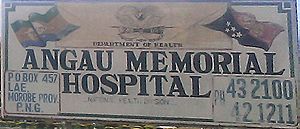ANGAU General Hospital facts for kids
Quick facts for kids ANGAU Hospital |
|
|---|---|
 |
|
| Geography | |
| Location | P.O. Box 457 Lae 411, Momase Region, Morobe, Papua New Guinea |
| Coordinates | 06°43′36″S 146°59′47″E / 6.72667°S 146.99639°E |
| Services | |
| Beds | 500 |
ANGAU Memorial Hospital is a very important hospital in Lae, Papua New Guinea. It's named after a special Australian Army group. This group was in charge of managing the areas of Papua and New Guinea a long time ago.
The hospital helps many people by offering medical care and specialist services. It serves people living in the Sepik, Madang, and Morobe provinces. In recent years, the Australian government has helped to improve the hospital. This was part of a deal with the Papua New Guinea government.
Contents
What Does ANGAU Mean?
ANGAU stands for the Australian New Guinea Administrative Unit. This was an Australian Army group created during World War II on March 21, 1942. Its main job was to manage the local areas of Papua and New Guinea.
When Japan joined the war, this army unit took over the running of these areas. They managed things from February 1942 until the war ended.
A Look Back at ANGAU Hospital's History
During World War II, a military hospital was set up in Lae. It was called the 2/7 Australian General Hospital. This hospital provided medical care for the Allied soldiers. In 1945, it was a large hospital with 1,200 beds. It even had beautiful gardens with local plants.
After the war, there were plans to build a new hospital for the local people. At first, some people wanted to keep separate hospitals for different groups. However, the plans for a new, combined hospital went ahead.
In 1963, a report showed that more money was being spent on improving services in New Guinea. This included building the ANGAU Memorial Hospital. It was meant to replace the old wartime hospital in Lae.
The ANGAU Memorial Hospital officially opened on April 17. It could care for 412 patients at one time. It also offered special medical services to about 620,000 people. These people came from the Sepik, Madang, and Morobe provinces. The hospital cost about £621,000 to build.
Medical Studies at ANGAU Hospital
Doctors at the hospital have also done important medical research. For example, between 1973 and 1987, they studied a type of bone cancer called Ewing's sarcoma. This study took place at the hospital's Cancer Treatment Centre.
Improving ANGAU Hospital: Redevelopment Plans
By September 2013, the hospital had become quite old and run down. Its buildings were even damaged by termites. Because of this, the Australian and Papua New Guinea governments agreed to renovate the hospital. This agreement was made on July 19, 2013.
At that time, ANGAU Hospital only had 12 of the 32 specialist doctors it needed. Also, only about 55% of its 729 staff positions were filled.
In February 2014, Australia's Minister for Foreign Affairs, Julie Bishop, spoke about the plans. She said the hospital was 50 years old and needed a lot of work. It had termites and asbestos, which is a harmful material. The goal was to make the hospital world-class.
More than K300 million has been invested in the hospital's redevelopment. This money helps with planning and half of the renovation costs. It will take two years to plan and design the new hospital. Major construction work started in 2016 or 2017.
Images for kids

